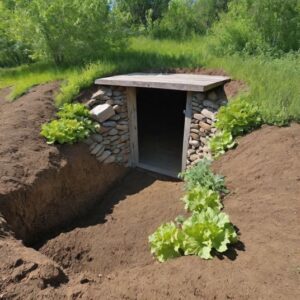What Is A Root Cellar?
A root cellar is a cool, dark storage space used for preserving vegetables and fruits for extended periods. Traditionally, root cellars were built into hillsides or dug underground to utilize the earth’s natural insulation. This environment helps maintain a stable, cool temperature that slows down the decay of stored food.

Root Cellar: Essential for Long-Term Food Storage
As Carla Emery explains in her book, The Encyclopedia of Country Living:
“A root cellar is a common term for a cool, dark place where vegetables and fruits can be stored for long periods. They were built into the side of a hill or dug into the ground to take advantage of the earth’s natural insulation. The cool, stable temperature of a root cellar can keep food from spoiling for months, making it an essential part of traditional food preservation.”
Emery, Carla. *The Encyclopedia of Country Living*. Sasquatch Books, 2003.
This practical and sustainable solution for food storage is a valuable asset for those interested in self-sufficiency and preparedness.
A root cellar is an underground or partially underground structure used for storing vegetables, fruits, and other perishable food items in a cool, stable environment. The design of a root cellar helps preserve food by maintaining a consistent temperature and humidity level, which slows down the decay and extends the shelf life of the stored items.
### **Key Features of a Root Cellar:**
1. **Temperature Control:**
– **Consistent Coolness:** Typically maintains a temperature between 32°F and 50°F (0°C to 10°C), which is ideal for storing root vegetables and other perishables.
– **Insulation:** The earth surrounding the root cellar acts as natural insulation, helping to stabilize the temperature.
2. **Humidity Regulation:**
– **Moisture Levels:** Root cellars generally maintain high humidity levels, which helps to prevent drying out and shriveling of produce. This is important for vegetables like carrots, potatoes, and beets.
3. **Ventilation:**
– **Air Circulation:** Proper ventilation is crucial to prevent the buildup of excess moisture and to provide fresh air, which helps to reduce the risk of mold and rot.
4. **Construction Materials:**
– **Traditional Materials:** Often built from stone, brick, or concrete, but can also be constructed using wood or metal.
– **Modern Variations:** Some root cellars are prefabricated or built into existing structures like basements.
5. **Accessibility:**
– **Entrance:** Typically has a door or hatch that allows easy access to the stored items. In older designs, the entrance may be a small, ground-level hatch or ladder.
### **Uses of a Root Cellar:**
– **Food Preservation:**
– **Vegetables and Fruits:** Ideal for storing root crops (potatoes, carrots, onions), apples, and other produce that benefits from a cool, dark environment.
– **Other Foods:** Can also be used for preserving canned goods, fermenting foods, and storing cheese or wine.
– **Extended Shelf Life:**
– **Seasonal Storage:** Allows for the storage of seasonal produce over the winter months, reducing the need for refrigeration and reducing food waste.
### **Building a Root Cellar:**
1. **Location:**
– **Site Selection:** Choose a location with good drainage and minimal exposure to the elements. A hillside or slope is often ideal.
2. **Design:**
– **Size and Shape:** Plan the size based on the amount of food you intend to store. Common designs include a small underground room or a larger structure with shelves.
3. **Construction:**
– **Digging and Excavation:** Digging the space out of the ground or creating an underground chamber. Ensure proper insulation and moisture control.
– **Ventilation and Cooling:** Install ventilation pipes or fans to regulate air flow and temperature.
A root cellar is a practical and sustainable solution for long-term food storage, making it a valuable asset for those interested in self-sufficiency and preparedness.